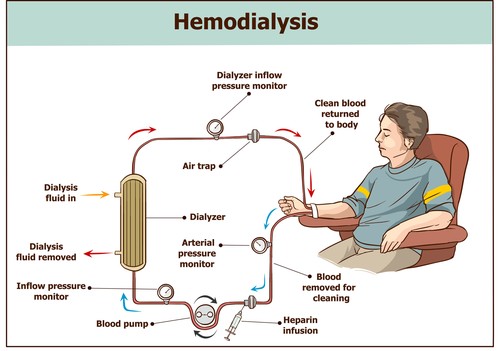Dialysis is a medical procedure used to treat patients with kidney failure. When the kidneys are unable to function properly, dialysis can help to remove waste and excess fluids from the body. This article will explain what dialysis is, why it is necessary, and how it is performed.
What is Dialysis?
Dialysis is a medical treatment used to remove waste and excess fluids from the body when the kidneys are not functioning properly. The kidneys filter blood and remove waste products, excess fluids, and other impurities. When the kidneys are unable to perform this function, dialysis is necessary.
Why is Dialysis Necessary?
Dialysis is necessary when the kidneys are no longer able to function properly. This can happen for various reasons, including chronic kidney disease, diabetes, high blood pressure, or a severe infection. When the kidneys are not functioning properly, waste products and excess fluids can build up in the body, which can cause a range of health problems, including:
- Fatigue and weakness
- Shortness of breath
- Swelling in the legs, ankles, or feet
- Loss of appetite
- Nausea and vomiting
- Itching
- Difficulty sleeping
- Cognitive impairment
- How is Dialysis Performed?
Dialysis can be performed in two ways: hemodialysis or peritoneal dialysis.
Hemodialysis:
Hemodialysis is the most common form of dialysis. It involves the use of a dialysis machine to filter the blood outside of the body. During hemodialysis, the patient’s blood is pumped out of their body through a catheter or fistula and into the dialysis machine. The machine then filters the blood through a special filter called a dialyzer, which removes waste products and excess fluids from the blood. The filtered blood is then returned to the patient’s body through another catheter or fistula. Hemodialysis treatments typically last around four hours and are usually performed three times a week.
Peritoneal Dialysis:
A Peritoneal dialysis is an alternative form of dialysis that involves the use of the patient’s own peritoneum, a thin membrane that lines the abdominal cavity, as a filter. During peritoneal dialysis, a special fluid called dialysate is injected into the patient’s abdominal cavity through a catheter. The dialysate remains in the patient’s abdomen for several hours, during which time it absorbs waste products and excess fluids from the blood. The dialysate is then drained from the abdomen and replaced with fresh dialysate. Peritoneal dialysis can be performed at home and does not require the use of a dialysis machine.
Complications of Dialysis:
While dialysis is a life-saving treatment, it can also cause a range of complications. Some of the most common complications of dialysis include:
- Low blood pressure
- Muscle cramps
- Nausea and vomiting
- Itching
- Infection
- Bleeding from the access site
- Anemia
- Depression
In addition to these complications, dialysis can also cause long-term damage to the body. Over time, repeated hemodialysis treatments can cause scarring of the veins used for access, making future treatments more difficult. Peritoneal dialysis can also cause scarring of the peritoneum, which can lead to long-term complications.
In conclusion, dialysis is a medical treatment used to remove waste products and excess fluids from the body when the kidneys are not functioning properly. Dialysis can be performed in two ways: hemodialysis or peritoneal dialysis. While dialysis is a life-saving treatment, it can also cause a range of complications and long-term damage to the body. If you have kidney failure or are



